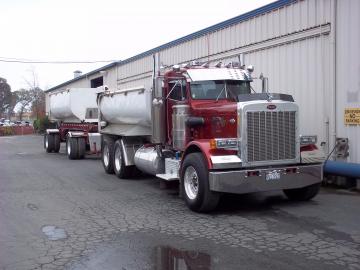The purpose of the tank is two fold, first as a filter and second as a treatment device. Most tanks are 1,000-2,000 gallons.

Material Transfer
Americans on average produce about 75 gallons per day of waste water. If you have a house with 4 people and a 1500 gallon tank, the water would stay in the tank for about 5 days. During these 5 days things happen.
First is settling. Every thing heavier than water sinks to the bottom and forms the sludge layer (cellular debris, cellulose, silica, borax). Everything lighter floats to the top (fats, oils, grease) and forms the scum layer. What remains in between is called effluent and is the only acceptable discharge into the drainfield. The tank is a series of baffles and sumps that ensure only effluent can pass. If too much solid waste is allowed to accumulate in the tank it begins to pass through to the drainfield, eventually clogging it to the point of failure.
The bacteria in the septic tank digest most of the solid waste that flows into the tank, and converts it into liquid and gas. Some solids can't be digested fast enough by the bacteria, and they begin to collect in the tank. As the tank begins to fill up with undigested solids it effectively becomes smaller. Because of reduced tank capacity the retention time is reduced, as a result the waste strength is increased. Increased waste strength over extended periods of time ALWAYS results in reduced system capacity and life.
Treated waste water exits the tank with vastly reduced waste strength (TSS, BOD, nitrate, sulfate, phosphates) and passes through an outlet pipe to a distribution box. The distribution box is small, (compared to the septic tank) often about 12"-18" across. It's purpose is to maintain equal distribution of waste water to the leach lines or pits (dry wells).
The drainfield is the area of ground that absorbs the treated waste water and may contain leach lines, pressure lines, dry wells, a soil mound, or a bed style absorption area.
Leach lines are trenches in the ground. They are usually 1-3 feet wide and 2-3 feet deep (deep trench leach lines can be 8 feet and deeper). Most leach line trenches are filled with gravel and are lined with perforated pipe that can conduct wastewater the length of the trench. The gravel is covered with filter-fabric to prevent it from being loaded up with soil back fill, usually the top 6-12 inches of the trench. Waste water soaks into the trench floor and sidewalls, and percolates down through the soil and eventually, joins with other ground water to complete the cycle. During this process it is filtered and purified.
Dry wells are very similar, but they are vertical bore holes, usually 3-4 feet in diameter and 25-45 feet deep.
This is merely a brief overview of the basic concepts of conventional gravity fed systems. More challenging site and elevation conditions give rise to more complex systems that use pumps, electronic timer controls, electric valves, and exotic filters.
However the basics still apply to all...filtration, waste strength reduction, and leaching into the ground.